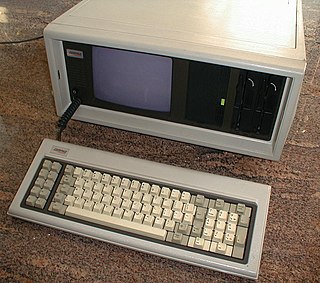
IBM PC–compatible computers are technically similar to the original IBM PC, XT, and AT, all from computer giant IBM, that are able to use the same software and expansion cards. Such computers were referred to as PC clones, IBM clones or IBM PC clones. The term "IBM PC compatible" is now a historical description only, since IBM no longer sells personal computers after it sold its personal computer division in 2005 to Chinese technology company Lenovo. The designation "PC", as used in much of personal computer history, has not meant "personal computer" generally, but rather an x86 computer capable of running the same software that a contemporary IBM or Lenovo PC could. The term was initially in contrast to the variety of home computer systems available in the early 1980s, such as the Apple II, TRS-80, and Commodore 64. Later, the term was primarily used in contrast to Apple's Macintosh computers.

The Hercules Graphics Card (HGC) is a computer graphics controller formerly made by Hercules Computer Technology, Inc. that combines IBM's text-only MDA display standard with a bitmapped graphics mode, also offering a parallel printer port. This allows the HGC to offer both high-quality text and graphics from a single card.

Microsoft Flight Simulator is a series of flight simulator programs for MS-DOS, Classic Mac OS, and Microsoft Windows operating systems. It was an early product in the Microsoft application portfolio and differed significantly from Microsoft's other software, which was largely business-oriented. Microsoft Flight Simulator is Microsoft's longest-running software product line, predating Windows by three years. It is one of the longest-running PC video game series of all time.
Sublogic Corporation is an American software development company. It was formed in 1977 by Bruce Artwick, and incorporated in 1978 by Artwick's partner Stu Moment as Sublogic Communications Corporation. Sublogic is best known as the creator of the Flight Simulator series, later known as Microsoft Flight Simulator, but it also created other video games such as Night Mission Pinball, Football, and Adventure on a Boat; educational software; and an Apple II graphics library.
Merge is a software system which allows a user to run DOS/Windows 3.1 on SCO UNIX, in an 8086 virtual machine.
Microsoft Flight Simulator began as a set of articles on computer graphics, written by Bruce Artwick throughout 1976, about flight simulation using 3-D graphics. When the editor of the magazine told Artwick that subscribers were interested in purchasing such a program, Artwick founded Sublogic Corporation to commercialize his ideas. At first the new company sold flight simulators through mail order, but that changed in January 1979 with the release of Flight Simulator (FS) for the Apple II. They soon followed this up with versions for other systems and from there it evolved into a long-running series of computer flight simulators.
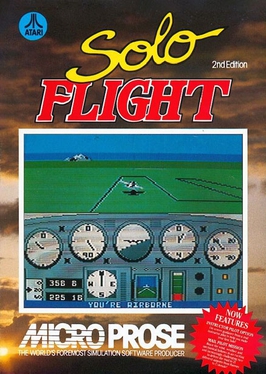
Solo Flight is a third-person flight simulator written by Sid Meier for Atari 8-bit computers and published by MicroProse in 1983. It includes a game mode called Mail Pilot. This was the fourth flight simulator Meier wrote for MicroProse—following Hellcat Ace, Spitfire Ace, and Wingman—and the first which did not involve aerial combat.
Bruce Arthur Artwick is an American software engineer. He is the creator of the first consumer flight simulator software. He founded Sublogic after graduating from the University of Illinois at Urbana–Champaign in 1977, and released the first version of Flight Simulator for the Apple II in 1979. His Apple II software was purchased by Microsoft in 1982 and became Microsoft Flight Simulator 1.0.

Microsoft Flight Simulator for Windows 95, abbreviated commonly as FS95 or FSW95, is a flight simulator video game. It was released in late 1996 for Windows.
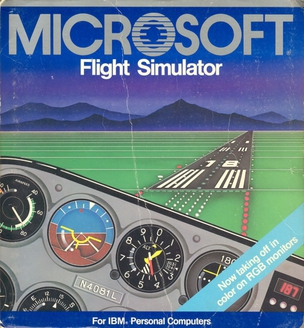
Microsoft Flight Simulator, commonly known as Microsoft Flight Simulator 2.0 or FS2, is a flight simulator video game. It was released in 1984 for the IBM PC as a self-booting disk.

Microsoft Flight Simulator, commonly known as Microsoft Flight Simulator 3.0 or FS3, is a flight simulator video game. It was released in mid-1988 for the MS-DOS.

Microsoft Flight Simulator, commonly known as Microsoft Flight Simulator 4.0 or FS4, is a 1989 video game developed by Bruce Artwick Organization and published by Microsoft.
Aces Game Studio (ACES) was an American video game developer based in Redmond, Washington, owned by Microsoft Game Studios. It was founded in 1988 under the name Bruce Artwick Organization Limited at Champaign, Illinois, by Bruce Artwick, creator of Microsoft Flight Simulator, Microsoft Space Simulator and also co-founder of Sublogic.

Jet is a combat flight simulator video game originally published in 1985 by Sublogic. The game was released in 1985 for MS-DOS and the Commodore 64, 1986 for the Apple II, 1988 for the Atari ST and Amiga, and 1989 for the Macintosh and NEC PC-9801.
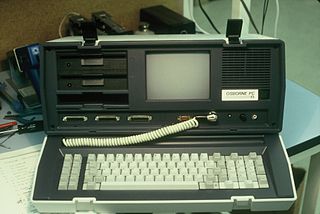
The Osborne PC is an unreleased IBM PC–compatible personal computer developed between 1983 and 1984 by Osborne Computer Corporation. Only prototypes of the computer were ever produced.

FS1 Flight Simulator is a 1979 video game published by Sublogic for the Apple II. A TRS-80 version followed in 1980. FS1 is the first in a line of simulations from Sublogic which, beginning in 1982, were also sold by Microsoft as Microsoft Flight Simulator.
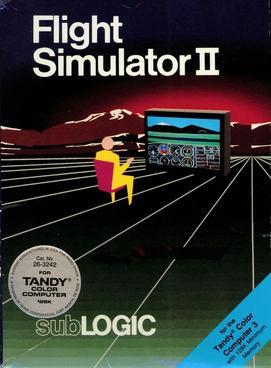
Flight Simulator II is a video game developed by Bruce Artwick and published by Sublogic as the sequel to FS1 Flight Simulator. It was released in December 1983 for the Apple II, in 1984 for Atari 8-bit computers and Commodore 64, in 1986 for the Amiga and Atari ST, the Atari XEGS as a pack-in title in 1987, and in August 1988 for the Tandy Color Computer 3.

Night Mission Pinball is a pinball simulation video game published by Sublogic in 1982. It was developed by Bruce Artwick for the Apple II, then ported to the Atari 8-bit computers, Commodore 64, and IBM PC.

Microsoft Flight Simulator is a 1986 video game developed by Sublogic and published by Microsoft for the Macintosh.

The Dimension 68000 is a microcomputer introduced by the Micro Craft Corporation in 1983 that sought to emulate the Apple II, the IBM PC, and various CP/M-centric computers through a family of coprocessor expansion cards and emulation software. The Dimension 68000 can also run as a standalone computer based on the Motorola 68000 from which it gets its namesake. The computer is mostly the brainchild of Mike Carpenter, a former executive of a scientific instrument manufacturer who incorporated Micro Craft in Dallas, Texas, to develop the Dimension 68000. It had a market lifespan of three years and received mixed, mostly positive, reception from the technology press. Criticism was leveled at the $6,250 price tag for the computer with the full deck of coprocessor cards, as well as the extent of the emulation power of those cards.
















